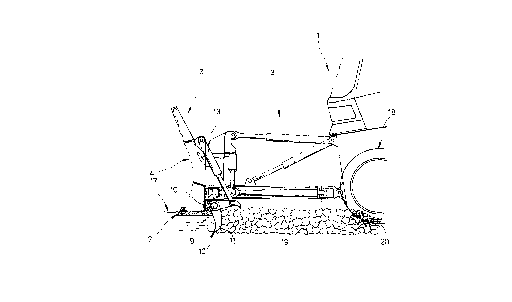Some of the information on this Web page has been provided by external sources. The Government of Canada is not responsible for the accuracy, reliability or currency of the information supplied by external sources. Users wishing to rely upon this information should consult directly with the source of the information. Content provided by external sources is not subject to official languages, privacy and accessibility requirements.
Any discrepancies in the text and image of the Claims and Abstract are due to differing posting times. Text of the Claims and Abstract are posted:
| (12) Patent Application: | (11) CA 2210539 |
|---|---|
| (54) English Title: | SKI RUN MAINTENANCE TOOL |
| (54) French Title: | OUTIL D'ENTRETIEN DE PISTE DE SKI |
| Status: | Deemed Abandoned and Beyond the Period of Reinstatement - Pending Response to Notice of Disregarded Communication |
| (51) International Patent Classification (IPC): |
|
|---|---|
| (72) Inventors : |
|
| (73) Owners : |
|
| (71) Applicants : |
|
| (74) Agent: | GOWLING WLG (CANADA) LLP |
| (74) Associate agent: | |
| (45) Issued: | |
| (86) PCT Filing Date: | 1995-10-27 |
| (87) Open to Public Inspection: | 1996-07-25 |
| Examination requested: | 1997-07-15 |
| Availability of licence: | N/A |
| Dedicated to the Public: | N/A |
| (25) Language of filing: | English |
| Patent Cooperation Treaty (PCT): | Yes |
|---|---|
| (86) PCT Filing Number: | PCT/EP1995/004233 |
| (87) International Publication Number: | EP1995004233 |
| (85) National Entry: | 1997-07-15 |
| (30) Application Priority Data: | ||||||
|---|---|---|---|---|---|---|
|
A ski run maintenance tool having a front-end moldboard and used to work and regenerate ski runs is improved to enable hard ski pistes to be worked in the simplest possible way. This is accomplished by equipping the lower back side of the moldboard (2) with rotatable renovator teeth (11) which can be pivoted through a setting device (13) from a ready position into a working position in which they cut into the base layer of the ski run.
Selon l'invention, un outil d'entretien de piste de ski pourvu d'un versoir à son extrémité avant et utilisé pour travailler et régénérer des pistes de ski est amélioré de sorte qu'il soit possible de travailler des pistes de ski dures de la façon la plus simple possible. On obtient cette amélioration en équipant le côté arrière inférieur du versoir (2) de dents de rénovation (11) rotatives que l'on peut faire pivoter, par l'intermédiaire d'un dispositif de réglage (13), d'une position de repos à une position de travail, position dans laquelle elles pénètrent dans la couche de fond de la piste.
Note: Claims are shown in the official language in which they were submitted.
Note: Descriptions are shown in the official language in which they were submitted.

2024-08-01:As part of the Next Generation Patents (NGP) transition, the Canadian Patents Database (CPD) now contains a more detailed Event History, which replicates the Event Log of our new back-office solution.
Please note that "Inactive:" events refers to events no longer in use in our new back-office solution.
For a clearer understanding of the status of the application/patent presented on this page, the site Disclaimer , as well as the definitions for Patent , Event History , Maintenance Fee and Payment History should be consulted.
| Description | Date |
|---|---|
| Application Not Reinstated by Deadline | 2000-10-27 |
| Time Limit for Reversal Expired | 2000-10-27 |
| Inactive: Abandoned - No reply to s.30(2) Rules requisition | 2000-02-24 |
| Deemed Abandoned - Failure to Respond to Maintenance Fee Notice | 1999-10-27 |
| Inactive: S.30(2) Rules - Examiner requisition | 1999-08-24 |
| Inactive: IPC assigned | 1997-10-09 |
| Inactive: First IPC assigned | 1997-10-09 |
| Classification Modified | 1997-10-09 |
| Inactive: Acknowledgment of national entry - RFE | 1997-09-25 |
| Letter Sent | 1997-09-25 |
| Inactive: Applicant deleted | 1997-09-23 |
| Application Received - PCT | 1997-09-23 |
| All Requirements for Examination Determined Compliant | 1997-07-15 |
| Request for Examination Requirements Determined Compliant | 1997-07-15 |
| Application Published (Open to Public Inspection) | 1996-07-25 |
| Abandonment Date | Reason | Reinstatement Date |
|---|---|---|
| 1999-10-27 |
The last payment was received on 1998-07-23
Note : If the full payment has not been received on or before the date indicated, a further fee may be required which may be one of the following
Patent fees are adjusted on the 1st of January every year. The amounts above are the current amounts if received by December 31 of the current year.
Please refer to the CIPO
Patent Fees
web page to see all current fee amounts.
| Fee Type | Anniversary Year | Due Date | Paid Date |
|---|---|---|---|
| MF (application, 2nd anniv.) - standard | 02 | 1997-10-27 | 1997-07-15 |
| Registration of a document | 1997-07-15 | ||
| Basic national fee - standard | 1997-07-15 | ||
| Request for examination - standard | 1997-07-15 | ||
| MF (application, 3rd anniv.) - standard | 03 | 1998-10-27 | 1998-07-23 |
Note: Records showing the ownership history in alphabetical order.
| Current Owners on Record |
|---|
| KASSBOHRER GELANDEFAHRZEUG GMBH |
| Past Owners on Record |
|---|
| GERD FRIEDMANN |
| HELMUT KANZLER |